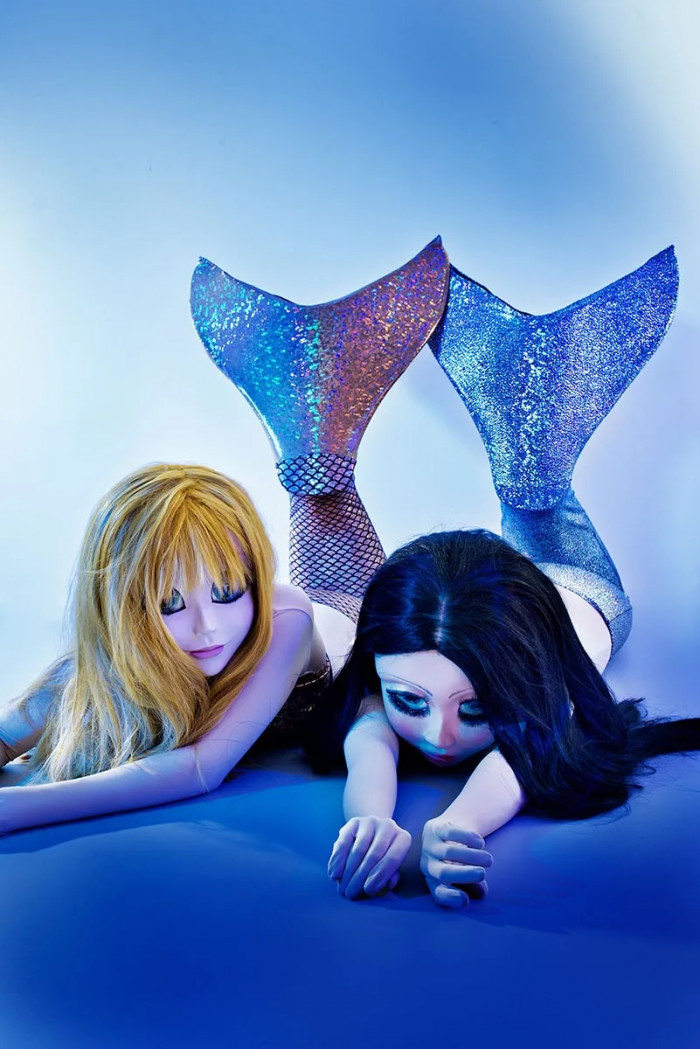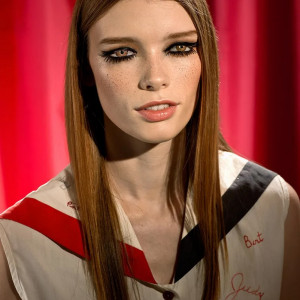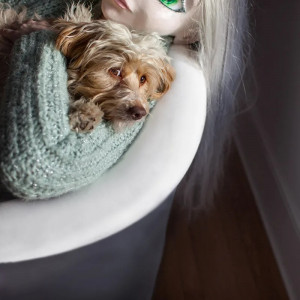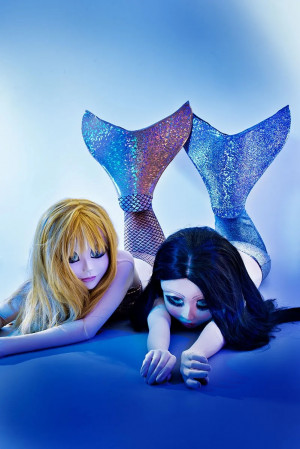March 7, 2014
Artist Laurie Simmons’s latest show is called “Kigurumi, Dollers and How We See,” and it opens tonight at Salon 94. After working on a more human scale in The Love Doll Days/Days 1-36, Simmons, who also happens to be the mother of Lena Dunham, decided to turn her eye to a Japanese subculture of cosplay (short for “costume play”) or Kigurumi.
Artist Laurie Simmons’s latest show is called “Kigurumi, Dollers and How We See,” and it opens tonight at Salon 94. After working on a more human scale in The Love Doll Days/Days 1-36, Simmons, who also happens to be the mother of Lena Dunham, decided to turn her eye to a Japanese subculture of cosplay (short for “costume play”) or Kigurumi. “I started down this rabbit hole of searching for the next iteration of doll something,” Simmons explained yesterday from her Tribeca studio. After exploring the popularity of Hatsune Miku, a Japanese Vocaloid pop star, she stumbled upon Dollers—people who wear bodysuits and latex masks, and appear publicly, in a kind of performance. “They wear ventilated suits, these Spandex onesies that cover their whole body, and then they have a mask that is their identity. It’s like a motorcycle helmet,” Simmons says. “And they go out and exist as their character.” Dollers can be men or women, straight or gay—their true identity is irrelevant to the persona they are presenting to the outside world. Vogue.com spoke to Simmons about her research and exploration through this fascinating subculture, and learned how, exactly, she transforms it into art.
What do you think is happening emotionally when people are putting on these costumes and presenting themselves as this identity?
Just based on the models that I used and the way they felt—I think it’s pretty exciting to assume another identity. For some reason, the posture of the model and the tilt of the head can read like the mask’s expression is changing. And what my model recently told me is that even though she’s wearing a mask, when she is posing or moving around, she is making very extreme facial expressions underneath.
Did you try one on?
I did. It’s not for me. It’s for me to photograph.
What were you going for aesthetically here?
I basically was doing the same thing I’ve been doing since my very first photographs. This was another iteration of women in interiors, only this time it was in a little abandoned brick house in the northwest corner of Connecticut that had beautifully colored walls and wall paintings and little windows on a scale that was really conducive to looking like my figures were standing in a dollhouse. The scale really worked for me. So really, it’s the same thing I’ve been shooting over and over again.
But these faces are terrifying.
It’s funny—this all gets back to the eyes of the beholder. I find them so beautiful. I don’t find them scary. Somebody told me the other day she thinks they are creepy, but she also told me that she doesn’t like clowns or puppets. There are some people who are visually open to that kind of thing and other people who find it more repulsive. I find the blonde—one with the yellow hair and also the character with the orange hair—to be exquisitely beautiful.
I suppose when you can’t look away—that is a kind of a beauty.
That could be a car wreck, too. Interestingly enough, the first art that I really looked at—or rather, my first consciousness of it—was an artist called Walter Keane who made these paintings of girls with big eyes. Everyone my age had the posters. He was the Thomas Kinkade of my childhood. Meaning, his work was everywhere—it was really cool to have a Walter Keane poster in your room. The girls had enormous eyes. And I think the Dollers reminded me of this Walker Keane connection. My sister actually pointed it out to me when she saw the picture.
That’s really interesting.
I’m excited to talk about it. So many things you do as an artist is about your unconscious informing your conscious mind. Constantly. Sometimes it’s like what you’re doing is uncovering memory.
I agree. And you’re trying to see what you’re trying to subconsciously express.
It’s often a delayed reaction. Oh yeah, that’s where that came from.
And what about that idea of the uncanny valley—does that factor into your work?
I think I’ve been playing around with the uncanny for so long it’s second nature to me. That’s why I’m telling you the girls look pretty. I think the other thing I always love as an artist is a metaphor or a conceptual hook. The idea of masking is so rich to me, especially with social media coming on so fast and so strong. My first awareness or understanding of the Internet was fear because I didn’t really know what was on the other side. I didn’t know who was in the chat room or with whom who I was e-mailing. We’ve all gotten over that now—but it’s still somewhat there, this idea that you might not really know with whom you are communicating.
Some people argue that privacy is dead online, that those early days of the Internet are over.
But how would privacy be dead? There are so many ways to still be masked. Do you feel like it’s still an atmosphere where a man could be a woman or someone old can be young?
I guess it feels like the Internet is losing a bit of edge or coolness to me—though I don’t know, when I found about the masking community . . .
That was too creepy to me, but it was part of the journey that got me to this place. I also tried to explore the women who are surgically enhancing themselves to become like Barbies. I reached out to a number of them because I thought I needed to shoot them. I was willing to fly somewhere, I was really desperate to turn my camera on one of them, but I couldn’t get a response. I couldn’t get anyone to pose for me.
You would think one of those women would be keen to show off her surgery to you.
That’s another thing—I really thought about the masking as a metaphor for aging. It’s really hard for me to figure out a way to talk about aging in my work. It’s important to me. And, well, masking is a way to get to that question—what are many women attempting to do as we age? The idea of letting it all hang out—even if it’s just letting your hair be gray—everyone is really reaching for some cover, some place to hide.
It’s terrifying.
But it’s acceptable because everyone agrees. Because we all agree that’s the way it should be. I’m not saying that’s not the way it should be, but I am thinking about it. Trying to make work about it.
It does feel . . . involved. To be presentable as a woman.
Yeah. When you’re younger, too, sometimes you need to leave the house—that’s a very elaborate mask that has to be put on.
It’s exhausting.
It would be easier to put on a Kigurumi head!
And is one of the models wearing a Rachel Antonoff shirt?
The two photos, yes, they are both wearing Rachel’s shirts. Did you figure what’s going on in those pictures? The eyes are closed. They have realistic eyes painted on their eyelids.
Oh my god!
Those are called my “How We See” photos—in fact, in the photos, you can’t see at all because your eyes are closed. When you are wearing the masks it’s hard to see—I imagine it looks a little bit like the afterlife. You do need to be led around. Sometimes I’d be working with my models, and I’d get really involved and say, “Come over here,” and I’d turn around to walk to another spot and I could see they were stepping gingerly from one place to another. I was like, “I’m so sorry, let me take your hand!” But they need to be led around. The whole idea of wearing a mask and being female and barely being able to see was so rich metaphorically. And then I was observing in my crazy research this other anime convention where girls would try to make themselves look like dolls by painting these huge eyes on their eyelids.
And that dog . . .
That’s Lena’s dog.
I thought so, those eyes are—
—unmistakable, I know. That particular model happens to be a dog whisperer and suddenly Lamby jumped up on her, and I thought, No, no, no, no, and then I looked through the camera, and said, “Yes, yes, yes.” The dog’s eyes looked so much more real, so much more human.
They really are. Have you seen that picture people think is of a Photoshopped dog with human eyes?
But that’s what Lamby looks like normally! Lena told me her boyfriend always looks at Lamby and says, “Who is in there?”
“Kigurumi, Dollers and How We See” opens today and is on view through April 28, at Salon 94 Bowery.

 ..
..
 ..
..
 ..
..